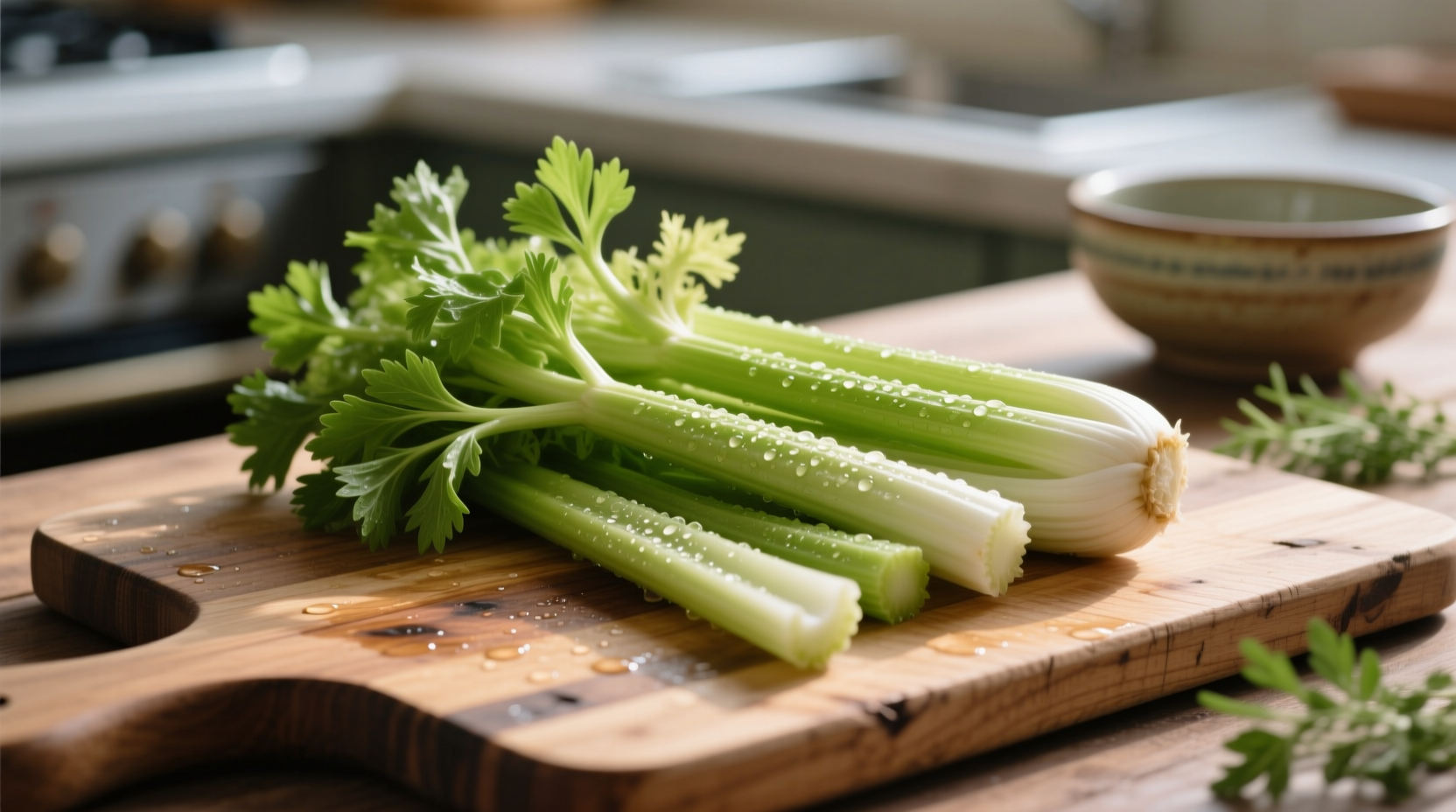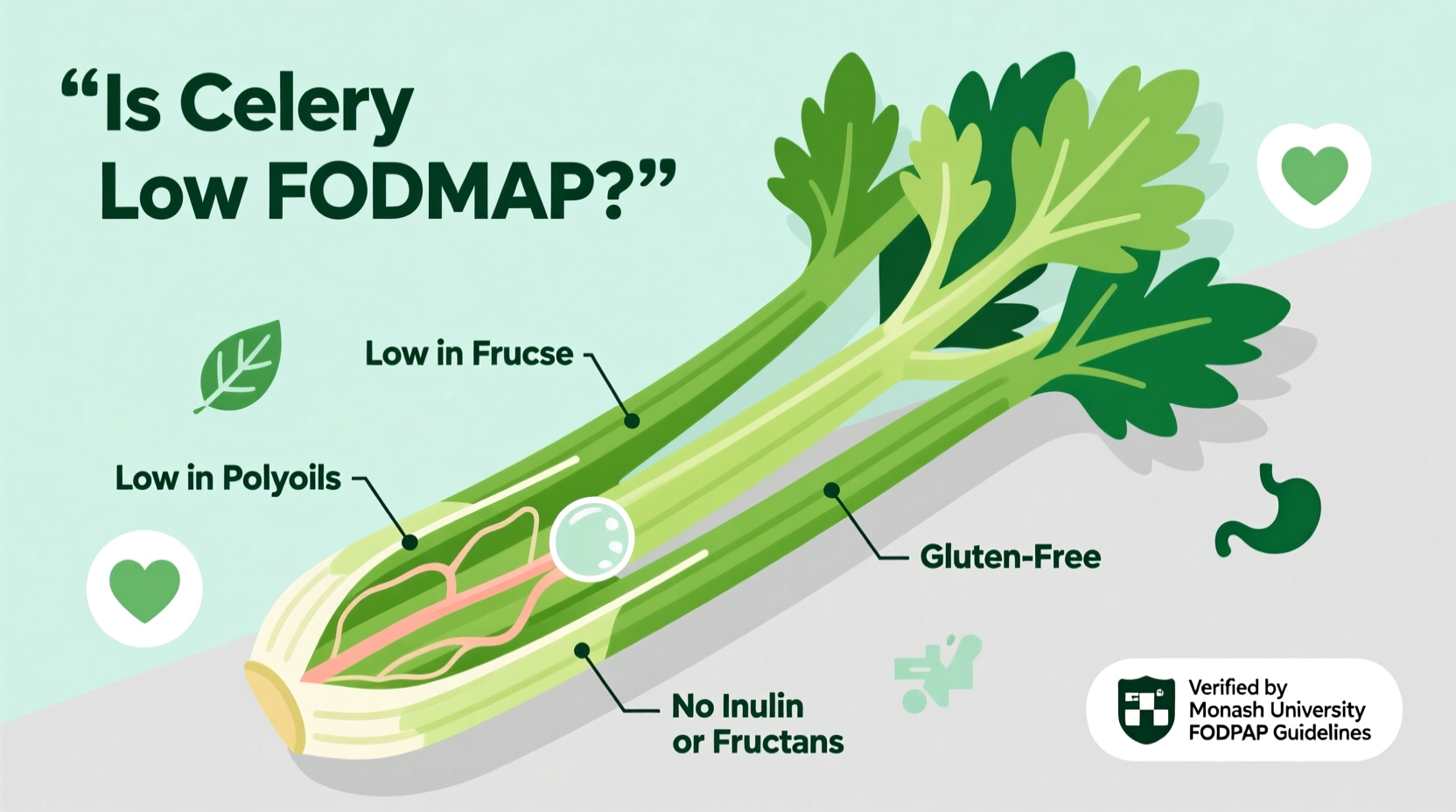Celery is low FODMAP in specific serving sizes. According to Monash University, the leading authority on FODMAP research, a low-FODMAP serving of celery is 1 stalk (approximately 4g). Larger servings become high FODMAP, with 3.5 stalks (14g) or more containing moderate to high levels of mannitol, a problematic FODMAP for sensitive individuals.
For those managing irritable bowel syndrome (IBS) or following a low-FODMAP elimination diet, knowing exactly which foods are safe is crucial for symptom control. This comprehensive guide provides evidence-based information about celery's FODMAP content, practical serving recommendations, and how to incorporate it safely into your diet without triggering digestive discomfort.
Understanding FODMAPs and Digestive Health
FODMAPs are short-chain carbohydrates that some people cannot properly absorb, leading to bloating, gas, abdominal pain, and other IBS symptoms. The low-FODMAP diet, developed by researchers at Monash University, has become the gold standard for managing IBS symptoms through dietary modification.
When following this diet, it's essential to understand that many foods contain FODMAPs in varying amounts. The key isn't necessarily eliminating all FODMAPs, but rather consuming them within your personal tolerance levels. This is where precise serving information becomes critical.
Celery's FODMAP Profile: The Science Behind the Serving Sizes
Monash University's extensive testing reveals that celery contains mannitol, a sugar alcohol classified as a polyol (one of the FODMAP groups). The FODMAP content varies significantly based on serving size and which part of the celery you consume.
Research shows the white stalk portion contains lower FODMAP levels than the green leafy parts. This distinction matters for those carefully managing their FODMAP intake during the elimination phase of the diet.
| Celery Serving Size | FODMAP Content | Low-FODMAP Status |
|---|---|---|
| 1 stalk (4g) | Low mannitol | Low FODMAP |
| 2 stalks (8g) | Moderate mannitol | Moderate FODMAP |
| 3.5 stalks (14g) | High mannitol | High FODMAP |
| 1 cup chopped (80g) | Very high mannitol | High FODMAP |
This precise data comes from Monash University's FODMAP app, which is regularly updated based on ongoing clinical research. Their testing methodology involves sophisticated chemical analysis to determine exact FODMAP concentrations in various foods.
Practical Application: Using Celery Safely in Your Low-FODMAP Diet
Knowing celery's FODMAP status is only half the battle—you need practical strategies for incorporating it into your meals. Here's how to use celery while staying within safe limits:
During the Elimination Phase
When first starting the low-FODMAP diet, strict adherence is essential. For celery:
- Limit to 1 stalk (4g) per serving
- Prefer the white stalk portion over the green leaves
- Measure portions carefully—don't eyeball servings
- Avoid celery juice, which concentrates FODMAPs
During the Reintroduction Phase
Once symptoms are controlled, you can test your personal tolerance:
- Start with 1 stalk and monitor symptoms for 72 hours
- Gradually increase to 2 stalks if no symptoms occur
- Test different forms (raw, cooked) as cooking can sometimes alter FODMAP content
- Keep a detailed food and symptom diary

Common Mistakes to Avoid with Celery and FODMAPs
Many people make these critical errors when using celery on a low-FODMAP diet:
- Underestimating serving sizes: A single stalk is much smaller than most people realize—about 4g, not the entire bunch
- Using celery leaves freely: The green leafy parts contain higher FODMAP levels than the white stalks
- Ignoring cumulative effects: Adding celery to other moderate FODMAP foods can push you over your threshold
- Assuming all preparations are equal: Celery juice or concentrated forms contain significantly higher FODMAP levels
Celery Alternatives for Different Culinary Uses
When you need to avoid celery completely or want variety, consider these low-FODMAP alternatives:
- For flavor base (mirepoix): Use 1/4 cup chopped carrots + 1/4 cup chopped green beans
- For crunch in salads: Cucumber (peeled), bell peppers, or bok choy
- For soup flavoring: Small amounts of leek (green part only) or chives
- For celery salt substitute: Fennel seeds (in small quantities)
Expert Tips for Maximizing Flavor While Minimizing FODMAPs
As someone who understands food chemistry, I recommend these professional techniques:
- Extract flavor without the fiber: Simmer celery in broth, then remove before serving to capture flavor without the problematic components
- Combine with FODMAP-fighting ingredients: Pair with ginger or turmeric, which may help reduce digestive discomfort
- Use celery seed sparingly: Just 1/8 teaspoon provides strong flavor with minimal FODMAP impact
- Freeze for convenience: Chop celery to proper portions and freeze in individual servings
When Celery Might Still Cause Issues
Even within recommended serving sizes, some individuals may experience symptoms due to:
- Individual sensitivity variations: Some people react to even low-FODMAP foods
- Combined triggers: Celery plus other mild triggers may exceed your threshold
- Preparation methods: Raw celery may be more problematic than cooked for some individuals
- Medication interactions: Certain digestive medications may affect tolerance
If you continue experiencing symptoms with appropriate servings, consult a registered dietitian specializing in the low-FODMAP diet. They can help identify whether celery is truly problematic for you or if other factors are at play.
Conclusion: Making Informed Choices with Celery
Celery can be part of a successful low-FODMAP diet when consumed in appropriate portions. By understanding the precise serving sizes, choosing the right parts of the celery, and being mindful of cumulative effects, you can enjoy this versatile vegetable without compromising your digestive health.
Remember that individual tolerance varies, so always personalize your approach based on your own symptoms and work with a healthcare professional when needed. The goal isn't perfection but finding your personal balance that allows for both symptom control and dietary enjoyment.











 浙公网安备
33010002000092号
浙公网安备
33010002000092号 浙B2-20120091-4
浙B2-20120091-4